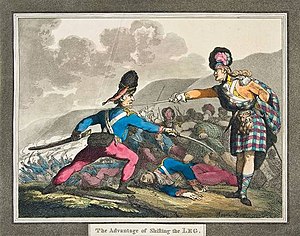
A rapier or espada ropera is a type of sword used in Renaissance Spain to designate a sword with a straight, slender and sharply pointed two-edged long blade wielded in one hand. It was widely popular in Western Europe throughout the 16th and 17th centuries as a symbol of nobility or gentleman status.

North Uist is an island and community in the Outer Hebrides of Scotland.

Robert Roy MacGregor was a Scottish outlaw, who later became a folk hero.

Rob Roy is a 1995 historical biographical drama film directed by Michael Caton-Jones. It stars Liam Neeson as Rob Roy MacGregor, an 18th-century Scottish clan chief becomes engaged in a dispute with a reprobate nobleman in the Scottish Highlands, played by John Hurt. Tim Roth won the BAFTA Award for Best Actor in a Supporting Role and was nominated for the Academy Award for Best Supporting Actor for his portrayal of Archibald Cunningham, one of Rob Roy's chief antagonists. Jessica Lange portrays Roy's wife, and Eric Stoltz, Brian Cox, and Jason Flemyng play supporting parts.

Swordsmanship or sword fighting refers to the skills and techniques used in combat and training with any type of sword. The term is modern, and as such was mainly used to refer to smallsword fencing, but by extension it can also be applied to any martial art involving the use of a sword. The formation of the English word "swordsman" is parallel to the Latin word gladiator, a term for the professional fighters who fought against each other and a variety of other foes for the entertainment of spectators in the Roman Empire. The word gladiator itself comes from the Latin word gladius, which is a type of sword.
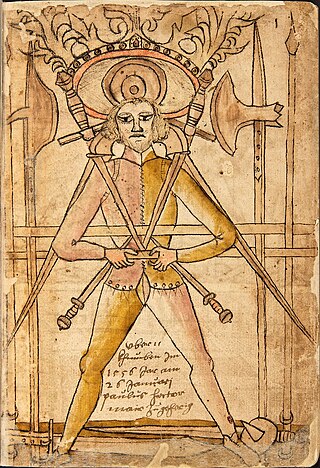
Historical European martial arts (HEMA) are martial arts of European origin, particularly using arts formerly practised, but having since died out or evolved into very different forms.
Martial arts manuals are instructions, with or without illustrations, specifically designed to be learnt from a book. Many books detailing specific techniques of martial arts are often erroneously called manuals but were written as treatises.

Clan MacDonell of Glengarry, also known as Clan Ranald of Knoydart & Glengarry is a Scottish clan and is a branch of the larger Clan Donald. The clan takes its name from River Garry where the river Garry runs eastwards through Loch Garry to join the Great Glen about 16 miles (25 km) north of Fort William, Highland. The progenitor of the MacDonells of Glengarry is Reginald, 4th great-grandson of the warrior Somerled. The clan chief is traditionally designated as the "Son of Alexander's son".
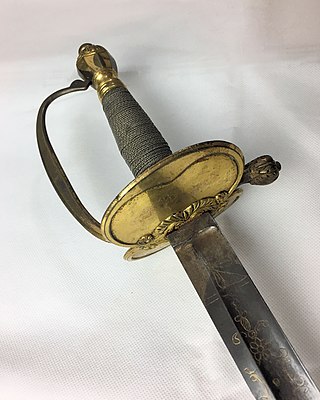
A spadroon is a light sword with a straight-edged blade, enabling both cut and thrust attacks. This English term first came into use in the early 18th century, though the type of sword it referred to was in common usage during the late 17th century. They were primarily used as a military sidearm in the late 17th and early 18th centuries, and for officers and NCOs in the latter part of the 18th and early 19th centuries. The type of sword also saw widespread use across Europe and America, though the term 'spadroon' is unique to the Anglophone world.

The term Italian school of swordsmanship is used to describe the Italian style of fencing and edged-weapon combat from the time of the first extant Italian swordsmanship treatise (1409) to the days of classical fencing.
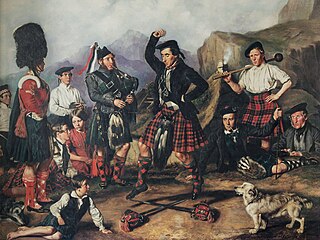
The Sword dance is one of the best known of all Highland dances, an ancient dance of war. Performance of sword dances in the folklore of Scotland is recorded from as early as the 15th century.

Clan Macdonald of Clanranald, also known as Clan Ranald, is a Highland Scottish clan and a branch of Clan Donald, one of the largest Scottish clans. The founder of the Macdonalds of Clanranald is Reginald, 4th great-grandson of Somerled. The Macdonalds of Clanranald descend from Reginald's elder son Allan and the MacDonells of Glengarry descend from his younger son Donald. The clan chief of the MacDonalds of Clanranald is traditionally designated as The Captain of Clanranald and today both the chief and clan are recognised by the Lord Lyon King of Arms, the heraldic judge in Scotland.

Clan MacDonald of Keppoch, also known as Clan MacDonellof Keppoch or Clan Ranald of Lochaber, is a Highland Scottish clan and a branch of Clan Donald. The progenitor of the clan is Alistair Carrach MacDonald, 4th great-grandson of the warrior Somerled. The clan chief is traditionally designated as the "Son of Ranald's son".

Alfred Hutton FSA was a British Army officer, antiquarian and writer. Serving during the Victorian era in the 1st King's Dragoon Guards, he played a major role in the revival of historical fencing in England, together with fellow fencers Egerton Castle, Ernest Stenson-Cooke, Sir Frederick Pollock and Walter Herries Pollock.
Andrew Ferrara or Andrea Ferrara was a type of sword-blade that was highly esteemed in Scotland in the sixteenth and seventeenth centuries. Sir Walter Scott notes that the name of Andrea de Ferrara was inscribed "on all the Scottish broadswords that are accounted of peculiar excellence".

A claymore is either the Scottish variant of the late medieval two-handed sword or the Scottish variant of the basket-hilted sword. The former is characterised as having a cross hilt of forward-sloping quillons with quatrefoil terminations and was in use from the 15th to 17th centuries.

The basket-hilted sword is a sword type of the early modern era characterised by a basket-shaped guard that protects the hand. The basket hilt is a development of the quillons added to swords' crossguards since the Late Middle Ages. In modern times, this variety of sword is also sometimes referred to as the broadsword.

Donald McBane was a noted Scottish swordsman, career soldier, and fencing master, who is widely regarded as one of the most prolific duelists of all time.
The Art of Defence on Foot was first published in 1798. It is a detailed manual of instruction for British military infantry swordsmanship. It is the oldest known British manual intended to teach purely military swordsmanship on foot. Four editions were printed between 1798 and 1824, the first three in London, UK and the last in New York, United States.
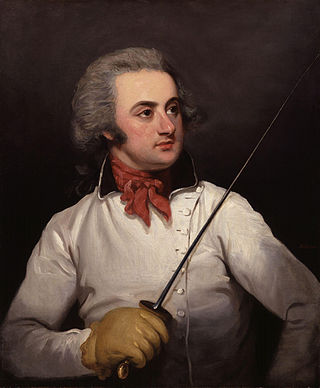
Henry Charles William Angelo (1756–1835) was an English memoirist and fencing master, as a member of the Angelo family of fencers and son of the Italian master, Domenico Angelo.

